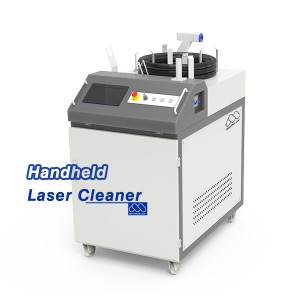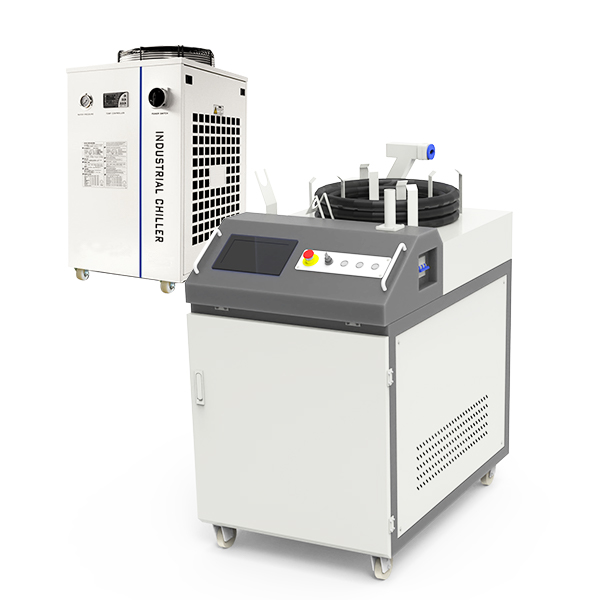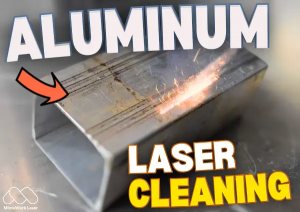A handheld laser cleaning machine is a portable device that uses concentrated laser beams to remove contaminants from surfaces.
Unlike larger, stationary machines, handheld models offer flexibility and ease of use.
Allowing operators to clean hard-to-reach areas or perform detailed work with precision.
Understanding Handheld Laser Cleaning Machines
These machines operate by emitting high-intensity laser light, which interacts with contaminants like rust, paint, dirt, and grease.
The energy from the laser heats these unwanted materials, causing them to evaporate or be blown away, all without damaging the underlying surface.
Handheld laser cleaning machines are designed to be user-friendly.
Often featuring adjustable settings for power and focus to accommodate different cleaning tasks.
Industrial Applications that
Benefit from Handheld Cleaning Laser
Handheld laser cleaning machines are versatile and can be employed across various industries.
Here are some applications that particularly benefit from their use:


Handheld Laser Cleaning Rust on Metal
1. Manufacturing
In heavy manufacturing, these machines are ideal for cleaning metal surfaces, removing welding slag, and preparing materials for painting or plating.
2. Automotive
The automotive industry uses handheld laser cleaners to remove rust and old paint from car bodies, ensuring a smooth surface for refinishing.
3. Aerospace
In aerospace manufacturing, precision is crucial.
Handheld laser cleaning can effectively remove contaminants from sensitive components without damaging them.
4. Construction and Renovation
Handheld laser cleaners are used to strip paint and coatings from surfaces, making them invaluable in renovation projects.
5. Marine
These machines can clean hulls of boats and ships, removing barnacles, marine growth, and rust, thereby enhancing performance and aesthetics.
6. Art Restoration
In the field of art restoration, handheld laser cleaning allows conservators to delicately clean sculptures, paintings, and historical artifacts without harming the original material.
Want to Buy a Laser Cleaner?
Differences Between
Handheld Laser Cleaner and Traditional Cleaning Machine
While both handheld laser cleaning machines and traditional cleaning machines serve the purpose of cleaning surfaces.
There are several key differences between the two:
1. Cleaning Method
• Handheld Laser Cleaner: Utilizes focused laser beams to remove contaminants through thermal processes, allowing for selective cleaning without physical contact.
• Traditional Cleaning Machine: Often rely on mechanical scrubbing, chemical solvents, or high-pressure washing, which can be abrasive or leave behind residues.
2. Precision and Control
• Handheld Laser Cleaning: Offers high precision, enabling operators to target specific areas without affecting surrounding surfaces. This is particularly beneficial for intricate or delicate tasks.
• Traditional Cleaning Machine: Generally lack the precision of laser systems, making them less suitable for detailed work, especially on sensitive materials.
3. Environmental Impact
• Handheld Laser Cleaner: Emits no harmful chemicals and generates minimal waste, making it an environmentally friendly option.
• Traditional Cleaning Machine: Often require the use of chemical cleaning agents, which can be harmful to the environment and pose safety risks.
4. Operational Flexibility
• Handheld Laser Cleaner: Being portable, these machines can be easily maneuvered around different job sites and hard-to-reach areas.
• Traditional Cleaning Machine: Typically larger and less mobile, which can limit their use in confined or complex spaces.
5. Maintenance and Durability
• Handheld Laser Cleaner: Generally requires less maintenance due to fewer moving parts, leading to lower long-term operational costs.
• Traditional Cleaning Machine: May require more frequent maintenance and repairs, especially if they rely on mechanical components.
Conclusion
Handheld laser cleaning machines are transforming the cleaning landscape across various industries.
Their precision, environmental benefits, and versatility make them an attractive choice compared to traditional cleaning methods.
As technology continues to advance, the adoption of handheld laser cleaning is expected to grow.
Paving the way for more efficient and sustainable cleaning solutions.

Handheld Laser Cleaning on Wood
Want to Know More About Laser Cleaner?
Related Machine: Laser Cleaners
|
Laser Power |
1000W |
1500W |
2000W |
3000W |
|
Clean Speed |
≤20㎡/hour |
≤30㎡/hour |
≤50㎡/hour |
≤70㎡/hour |
|
Voltage |
Single phase 220/110V, 50/60HZ |
Single phase 220/110V, 50/60HZ |
Three phase 380/220V, 50/60HZ |
Three phase 380/220V, 50/60HZ |
|
Fiber Cable |
20M |
|||
|
Wavelength |
1070nm |
|||
|
Beam Width |
10-200mm |
|||
|
Scanning Speed |
0-7000mm/s |
|||
|
Cooling |
Water cooling |
|||
|
Laser Source |
CW Fiber |
|||
|
Laser Power |
3000W |
|
Clean Speed |
≤70㎡/hour |
|
Voltage |
Three phase 380/220V, 50/60HZ |
|
Fiber Cable |
20M |
|
Wavelength |
1070nm |
|
Scanning Width |
10-200mm |
|
Scanning Speed |
0-7000mm/s |
|
Cooling |
Water cooling |
|
Laser Source |
CW Fiber |
FAQS
It’s user - friendly. Just follow these steps: First, ensure proper grounding and check the red light indicator. Then, adjust power and focus based on the surface. During use, wear protective glasses and move the handheld gun steadily. After use, clean the lens and secure the dust cap. Its intuitive controls make it accessible even for new users.
It works on many surfaces. For metal, it removes rust, paint, and oxide. On wood, it restores surfaces by eliminating stains or old finishes. It’s also safe for delicate materials like aluminum (when the gun head is tilted to avoid reflections) and useful in art restoration for cleaning artifacts without damage.
Regular upkeep is simple. Before each use, inspect and clean the protective lens with alcohol - moistened tools if dirty. Avoid twisting or stepping on the fiber cable. After use, put on the dust cap to keep the lens clean. For long - term use, add a dust collector near the laser output to reduce debris buildup.
Post time: Jan-02-2025






